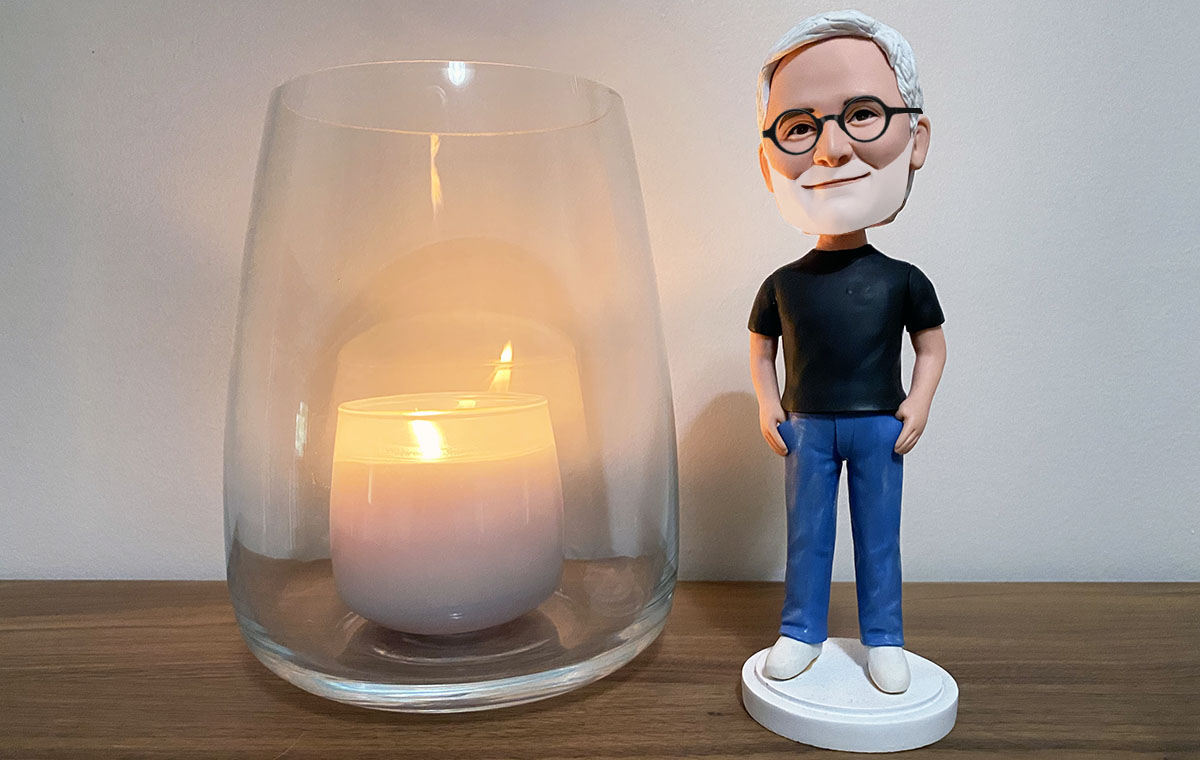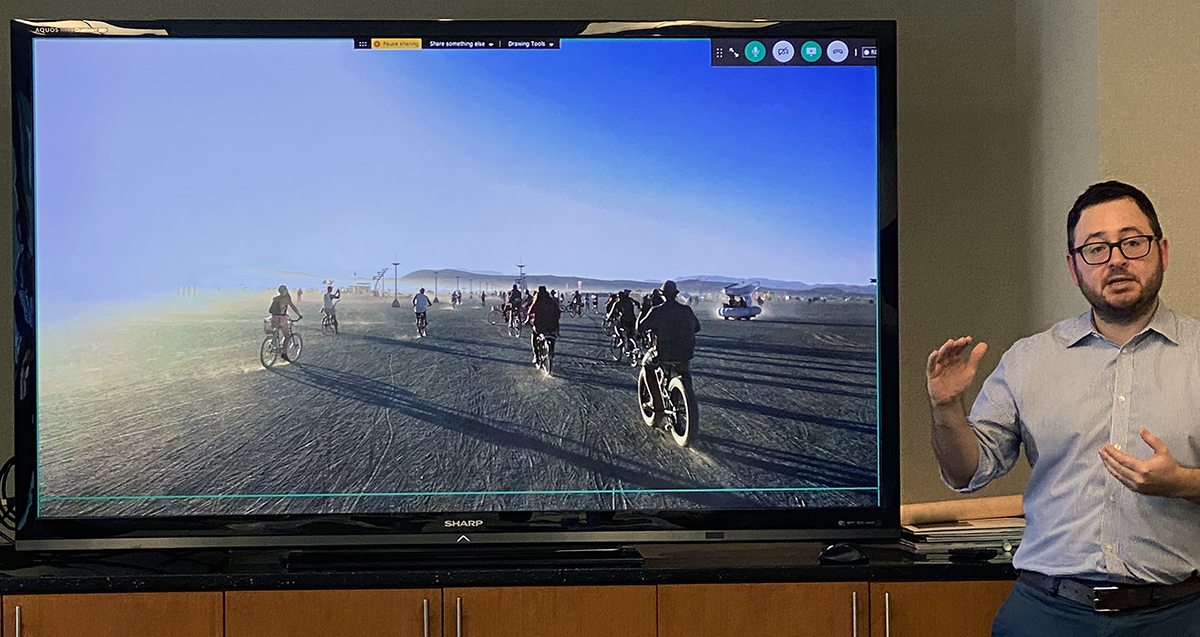Presenting on any subject can be a frightening experience for most people, but when you have to do it in a room full of people you work with there could clearly be moments of embarrassment that would be relived at office Christmas events for years to come … but not for the people in my office. Nope. We are all going to be seasoned public speakers before too long because we started a program that allows people WHO HAVE VOLUNTEERED to actually practice their public speaking skills.
We call this program “7 Minutes in Heaven” and it is working out really, really well so far.

I think we can all acknowledge that candlelight makes me look even sexier when in doll form, but why am I showing you a bobblehead doll of yours truly? Well, this is the token that will be passed from one presenter to the next – consider it a passing of the torch – when it is your turn to present. Since this program is one of my projects, it only makes sense that if you are possession of “me” that you are the next person up for presenting. I do hope that I am treated with respect but I’m not sure that’s the vibe I put out there just yet.
It was about 5 months ago that I first introduced this speaking program at the office, I even wrote about it (7 Minutes in Heaven) and explained the reasons behind the presentation format as well as why we were doing this sort of thing. What I didn’t cover in that original post was the “HOW” behind this program and considering how well things are going, I felt it was time for an update.
When we have a “7 Minutes in Heaven” presentation, about two weeks out I personally meet with the individual who is up next. I’m just going to call that person “Luis” because, in the case of today’s post, Luis Spinola was the person who presented. So Luis and I met to discuss his topic and review the story arc for his presentation. Most people don’t really realize how fast seven minutes pass by and as we review the narrative, we discuss what really matters and how the presentation could be organized. As part of this particular initial meeting, I wrote notes down as Luis and I were chatting and they became the backbone of today’s blog post … so let’s get into it.
With each presentation, the specific points we discuss get a bit longer – this way everyone can learn from the challenges of past presentations. I am only hitting the high point in this first meeting but let me share with you what the following notes mean.

The first sketch at the top was a discussion on how to organize the slides in Luis’s presentation. Is each slide a stand-alone image with notes delivered all at once? Or is it a series of images that build upon one another? i.e. One picture that has additional information continuously layered on top until you reach “the next” slide.

With item number 1, we discussed that if you have 7-10 minutes allocated for your presentation, plan to fill 6 minutes. That extra few minutes will sometimes (unfortunately) get filled with ah’s and um’s, but since you should be working without a script, you will embellish parts and add some flourish along the way. It always happens. The only real way to get your timing down is to practice. Another way that you can work on your timing is to understand the point of the graphics you choose and use them as indicators of what you should be talking about – this can frequently cut down on the amount of “freelancing” you might do when speaking.

The next item to work on are those dreaded verbal pauses … we all know what I’m talking about, and yes, everyone does them. Removing all the “ah’s”, “uhm’s”, “like’s”, and “you know’s” is one of the more difficult things to master but it can be done. Most verbal pauses are a result of the speaker trying to remember what they are supposed to say and while their brain searches for a particular word or phrase, your mind fills that void with an unnecessary word. The other item is “the Stammer” … similar to the verbal pause, recognizable by saying a single verbal pause word several times back to back to back to back. This happens when a person isn’t trying to remember what they want to say, it’s when they are trying to figure out what they want to say when they have a few options in their head. I’m not convinced that you can completely remove these things from your thought process but you can train yourself to quit saying them aloud. When you have a non-verbal pause, this simply comes across as you being thoughtful in the words you choose instead of you coming across like you are trying to figure out what you are supposed to say.

I thought item number three would be fairly obvious but I’m learning that it isn’t. There is an overwhelming compulsion for people speaking to a smallish room of 15 or so people to turn towards the tv monitor – basically looking at their presentation like everyone else in the room – and speaking with their back to the audience.
Don’t do this!
Quick glances are perfectly fine but you want to actually make eye contact with the people you are speaking to – it will make your presentation about 1000x more meaningful to the listener. You should also think about projecting your voice to the back of the room, especially since these gatherings are not so large that you would be using a mic to amplify your voice.

The last biggie item we discuss is how to move around in the room along with a very simple technique that will help you make sure you are “working” the entire room. I tell people that when you are presenting using a tv monitor and there is a table of people facing you, occasionally you should switch from one side of the tv to the other. When you stand statue-like in a single spot, you are probably making it difficult for some of the people facing you to actually see your presentation currently on the monitor.
The other tip from this diagram is what I call “The Dr. Pepper” – a phrase that most people justifiably don’t understand. When people present – and I have been guilty of this myself which is why I came up with this technique, and subsequently, the name – they tend to find a friendly face in the crowd that they look at almost exclusively, and as a result, they basically deliver their presentation to that single person. I now tell people to scan the room – preferably find at least 3 spots – and rotate their view and attention between those spots. Pretend you are standing at the 6:00 position on a clock – you want to find someone at the 10:00, 2:00 and 4:00 position.
Now that I’ve explained it, I’ll bet you can figure out why I call it “The Dr. Pepper.”

So back to Luis, the recipient of these tutorial notes and the speaker at today’s “7 Minutes in Heaven”. Luis chose to discuss his trip and experience at the Burning Man event that took place last August. Other than completely blowing the time parameters, Luis took all this above guidance into consideration and absolutely destroyed his presentation. The graphics were amazing and the narrative he prepared to convey his subject matter was engaging and evocative. I left, along with everyone else, convinced that not only do I need to go to Burning Man 2020, I need to go with LUIS!!

Immediately after his presentation, Luis and I met to discuss how things went, how he felt, any challenges, realities vs. fictions, etc. We had a few items to review and items that he will need to continue to improve but I don’t think anything he heard was a surprise except for how far over the time requirement he went … but nobody cared because we were so entertained by what was happening right in front of us.
I believe this is the 4th presentation in this series and the feedback I’ve heard so far has been overwhelmingly positive and we have an excess of people volunteering to go next … which is why Bob Bobblehead started this post off. The outgoing presenter gets to decide who goes next with a non-ceremonial “passing of me” … a phrase I’m not crazy about.
Cheers,

